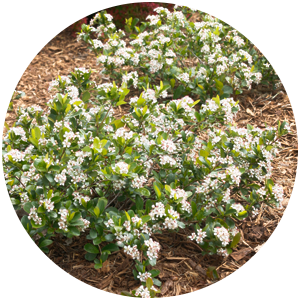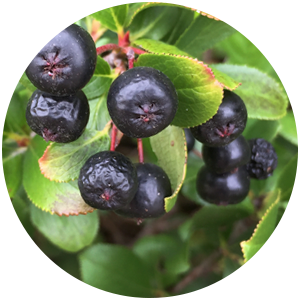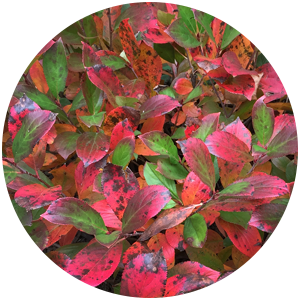LOW SCAPE MOUND™
ARONIA
This Rugged Beauty is for the Birds
- Versatile native shrub
- Low to no maintenance
- Heat and drought tolerant
- White flowers in spring attract pollinators
- Brilliant red fall foliage
- Birds enjoy its fall fruits
- 12-24″ tall x 18-26″ spread
- Hardy in USDA Zones 3-9
We all could use a few more plants in our gardens that require no assistance from us to look fabulous, right? That describes Los Scape Mound Aronia to a tee. Sun, part shade, wet, dry, hot or cold–it takes it all in stride without skipping a beat. Hundreds of dainty white flowers cover the glossy green, mounded foliage in spring followed by a spectacular fall color show and dark purple fruits to feed the birds. So, go ahead and throw your landscape challenge at it. Low Scape Mound can take it!
how to grow low scape mound™ aronia

Planting
Low Scape Mound™ Aronia is not picky about where you want to plant it and will survive just about anywhere except deep shade. Choose a spot in your landscape where you could use a mass planting or border of low growing, glossy green plants that you won’t need to fuss over. Keep in mind that it will produce the showiest display of flowers, fruit and fall color if you plant it in full sun.
This shrub will grow in dry areas, but it also grows in wet soil and everything in-between. Once its roots are established, you won’t need to worry about watering it unless you live in an area with prolonged drought.
When planting, dig the hole about twice as wide but just as deep as the container it is growing in. If the roots are densely circled around when you take the plant out of the pot, loosen them up a bit to break the “root memory”. This will encourage them to grow outward instead of continuing to grow in a circular pattern.

Fruiting tips
- Aronia’s common name, chokeberry, comes from the extremely astringent taste of the fruit. Birds and other wildlife love it, but it’s too sour for the human palate.
- Although the fruit is often referred to as a berry, Aronia is closely related to apples and its fruit is actually a pome. Unlike apples, Aronia is self-fruiting and does not require a pollinator for fertilization and fruit set.
- All types of Aronia need to go through a cold winter for flowers, and thus fruit, to be produced.
- This plant will produce the largest quantity of evenly ripe berries when planted in full sun (6+ hours of direct sun per day.)
- If you prune this shrub right after it flowers, no berries will be produced.

Pruning
Some larger varieties of Aronia require quite a bit of pruning. But since Low Scape Mound™ is a compact, low mounded selection, it won’t need to be pruned to maintain its attractive shape. It can live its whole life without being pruned.
However, if you’d like to make it smaller, you can trim it. Aronia sets next year’s flower buds on this year’s stems, so if you choose to prune it you’ll need to do so right after it blooms in spring. Doing so will eliminate the berries that fall, but if will bloom again the following spring.
Set the plant in the hole, making sure that the top of the rootball is level with the top of the surrounding soil. Then backfill the hole with the soil you dug out. Press it down with your hand firmly to eliminate any big air pockets around the roots.
Lastly, water the plant again to help the soil settle. Spread some mulch around the base of the plant, taking care to keep it from touching the plant’s stems. The mulch will help to retain soil moisture and protect the roots during winter.
“Just planted three this spring, and so far they have grown and thrived producing beautiful red color for the fall! i am very happy with the hardiness and seasonal interest of these plants. i hope they survive a midwest winter!”
-j hilpert, sartell, minnesota
top 3 reasons to grow
LOW SCAPE MOUND™ ARONIA
it benefits pollinators and wildlife
You’ll find all sorts of pollinating insects on this native shrub when it’s in bloom. Plus, its fall fruit is an excellent food source for birds and other wildlife.
great bang for the buck
Just plant it and forget it…although we think you’ll find that its spring floral show and fiery red fall foliage is truly unforgettable!
it will grow almost anywhere
Sun, part shade, sand or clay, wet or dry, extreme cold or sweltering heat–nothing phases this rugged beauty.
